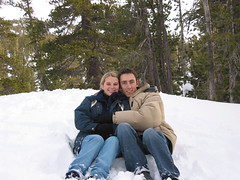An Australian, an American, and two Vietnamese in a Russian built car with Canadian stickers on it......
This morning we packed up our gear, had breakfast in our hotel and headed on our tour to Cuc Phuong National Park. Our tour consisted of driver, guide, and us in a Lada (the Russian built car). We drove through small villages, flooded rice paddies and sugar cane fields. There were farmers ploughing fields with water buffalo and planting rice, groups of women cutting down sugar cane by hand, and lots of kids riding bikes home from school. Since it was only 9:30 we asked our guide if they were out for the day and he said that they were going home because it was too cold (too cold being about 12C). They usually finish around 11:30am, and start around 7:30 in winter and 6:30 in summer. Our first stop was the Endangered Primate Rescue Centre. At the entrance was a few plaques listing associations and zoos around the world that support them. We were pleased to see Adelaide Zoo, Australia and San Diego Zoo, USA. The German woman that worked there said that Australiais very supportive of the centre. We walked through some rows of enclosures with different types of Langurs and Gibbons (Nige kept singing the 'Funky Gibbon' song from the Goodies). The centre confiscates most of them from illegal traders selling them to China for medicinal purposes. They have been succesful in breeding most of the types and we saw a few babies in family groups, the biggest group being 9.
The Red-Shanked Douc Langurs (Leaf Monkey) were probably one of the larger Langurs at just over two feet tall (body size, as the tail is about 4 feet itself, and their arms are just as long). Their fur is multiple colours. Their legs are a reddish brown, their arms and tails are white, their bodies are grey, and their face is orange with long white beards. There was also grey-shanked and black-shanked Langurs their legs being grey and black. As the some of the Langurs are from the south of Vietnam they have heated accomodation, unlike some of the staff apparently. The 'Funky' Gibbons were more active, swinging around on the bamboo rungs and chasing each other. One little baby was doing huge swings between rungs and performing flips and twists for our entertainment. The females are orangie-brown and the males are black. All the babies are born orangie-brown and all turn black after a few months. After 4 years the females turn back to orangie-brown and the males stay black. One of the older white cheeked Langurs had a bit of an attitude and sat there staring. He gave an upward nod toward us and Nige returned the nod. This went on for a bit until we lost interest. The guide said he was angry at something, maybe at the others across the path in their 4 star heated accomodation.
The centre has a semi-wild sanctuary attached where they release some of them after graduation. It is here that they hopefully remember how to eat and look after themselves again. Some of the less threatened species then graduate with their masters and are released back into the wild. They currently have 5 Langurs and 2 Gibbons in the 'Semi-wild' enclosure. Although different species they eat different foods so there is no competition. The poachers in Vietnam are not punished for capturing and selling the primates, according to our guide. They are usually poor people that are just trying to get some money. Unfortunately this does not deter them from poaching.
Our first stop in the National Park was the 'Cave of Prehistoric Man'. In a cave on a mountain there was the graves of 3 people said to be 7500 years old. They found tools and shells in the cave also. This is thought to be the site of the Vietnamese ancestors. Our guide said that the Chinese claimed that the Vietnamese people came from China, and having discovered this maybe it was the other way around. We stopped for lunch (french bread and salad) and walked 3 kms to a 1000 year old tree. The walk was through tropical jungle and as we walked higher we were surounded in fog. We passed a Liana tree (like a vine) that was like a python winding its way through the jungle apparently for 1km. There was some huge banana trees that no longer fruit. We learned that on banana plantations the tree is replanted each year to produce edible fruit. The 1000 year old tree was large compared to the others in the jungle but after seeing the Sequoias in California it isn't that spectacular. The walk through the jungle was excellent and we enjoyed the park and appreciated a guide who spoke english.
Back in Ninh Bihn we booked the overnight bus to Dong Ha. Waiting at the hotel for the bus we watched a bit of the South East Asia ABC (the Aussie version) which was nice to see. The bus left at 9:30 and we were on our way.


0 Comments:
Post a Comment
<< Home